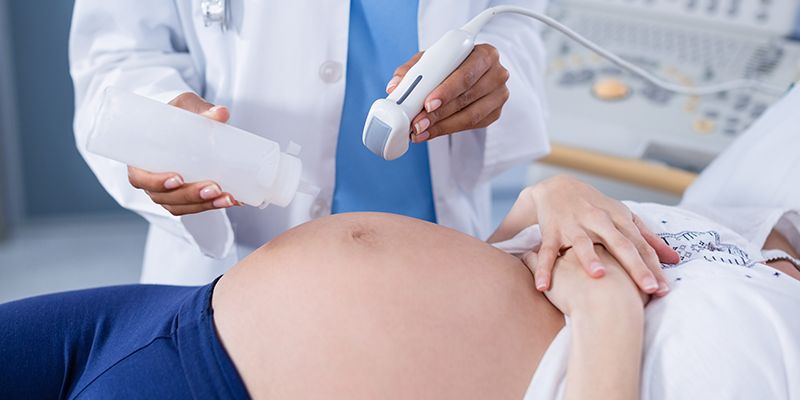
New scanning protocols have been drawn up for the thousands of expectant parents affected by pregnancy complications each year.
Research led by the University of Leeds will for the first time provide sonographers with specific words and phrases to be used consistently when explaining miscarriages, fetal deaths and anomalies during scans.
At present, there is no standardised way of communicating scan findings, which can lead to increased distress for the expectant parents.
Each year about 150,000 families in England and Wales are affected by pregnancy complications: 20% of pregnancies end in miscarriage or stillbirth, while one in 20 scans reveal an anomaly which could indicate the presence of a foetal health condition.
“We hope that these guidelines can both improve the experiences of expectant parents in the UK and help to shape news delivery policy in other countries.”
Parents often recall the exact words and behaviours that the sonographer used when conveying unexpected news.
The new training framework, published in Ultrasound, will help sonographers provide clear information for expectant parents in stressful situations.
Dr Judith Johnson, a Clinical Psychologist at Leeds’ School of Psychology, led the research.
She said: “The language used during scans can have a powerful emotional impact on the parents.
“It can influence how they respond to the news, and any decisions they then make regarding how to move forward.
“Addressing this issue has been particularly challenging because sonographers may have to communicate a wide variety of findings to parents, from miscarriages to a specific type of fetal anomaly.
“However, sonographers receive no mandatory training in news delivery and up until now, there was no agreed guidance for how to communicate these findings to expectant parents.”
A wide range of charities, international academics, healthcare professionals and policy experts worked together on the new, comprehensive set of guidelines.
The recommendations include:
• prioritising the use of honest and clear communication
• using technical terms, but these should be written down for parents, together with non-technical interpretations
• the term ‘baby’ should be used as a default, even in early pregnancy, unless expectant parents use other terminology such as ‘fetus’
• at the initial news disclosure, communication should focus on providing information
• expectant parents should not be asked to make decisions during the scan
Dr Johnson said: “These are the first consensus guidelines for news delivery in ultrasound which have been published anywhere in the world
“We hope that these guidelines can both improve the experiences of expectant parents in the UK and help to shape news delivery policy in other countries.
“We also anticipate that these guidelines will help to reduce sonographer anxiety around news delivery.”
Ruth Bender Atik, National Director of The Miscarriage Association, said the guidelines could make a major contribution to patient care.
“The guidance focuses on key aspects of the ultrasound experience in pregnancy, from the first hello through to discussing next steps.
“They suggest specific words, phrases and behaviours that can best serve their patients and they remind practitioners not to make assumptions about how news may be received.
“We are delighted to have been involved in their development and will share them widely.”
Julian Hallett, Services Development Manager at the Down’s Syndrome Association, said: “We were very pleased to be involved in the important project.
“Sonographers have a crucial role to play in pregnant women’s antenatal care. It is vital that sharing news of an ‘unexpected’ finding in a scan is done with sensitivity and compassion.
“This resource gives guidance on how best to approach this, developed by a range of professionals who have thought this through carefully.
“Sonographers also need to know they can refer women for additional information and support from a range of relevant organisations, including support available from the Down's Syndrome Association.”
Jane Fisher, Director of Antenatal Results and Choices (ARC) said: “We hear regularly from parents who have had unexpected news from scans and know how sensitive they can be to how the information is conveyed.
“We also run training for sonographers and know how keen they are to ‘get it right’. We welcome these resources as they will help equip sonographers to provide high quality care to parents and avoid causing extra distress in these challenging circumstances.”
Gill Harrison a sonographer at The Society and College of Radiographers, was also involved in drawing up the guidelines.
She said: “Sonographers have for many years been taught to deliver unexpected findings detected during an ultrasound scan using methods originally designed for oncologists.
“Unfortunately the setting is completely different in ultrasound. Sonographers are not always expecting to find an abnormality or miscarriage.
“It is often not until they start scanning that they realise things are not as they should be, leaving little time for preparation.
“To have a framework specifically designed for obstetric ultrasound practice, with clear examples from experts within the field will help in the education of student sonographers and assist experienced practitioners to develop their skills.
“This should not only help build confidence and skills in the ultrasound community, but also lead to better patient care and satisfaction in what can be extremely challenging circumstances for all involved.”
Further information:
Top image: Freepik.com
UK consensus guidelines for the delivery of unexpected news in obstetric ultrasound: The ASCKS framework is published 5 August in Ultrasound, the journal of the British Medical Ultrasound Society.
The ASCKS framework research was funded by the Society and College of Radiographers, and the University of Leeds.
Framework contributors include: The Miscarriage Association; SANDS (Stillbirth and Neonatal Death Society); ARC (Antenatal Results and Choices); The Downs Syndrome Association; The Society and College of Radiographers; SHINE (the organisation for Spina Bifida and Hydrocephalus); Public Health England; Department of Health and Social Care.
For further information contact University of Leeds press officer Ian Rosser at i.rosser@leeds.ac.uk